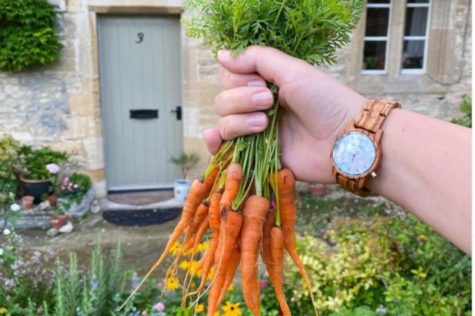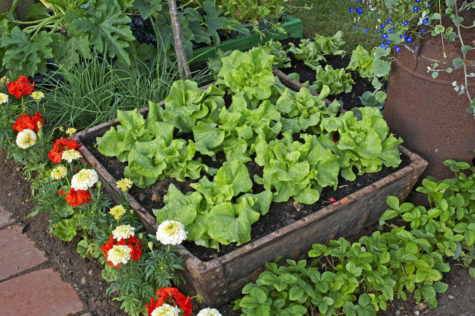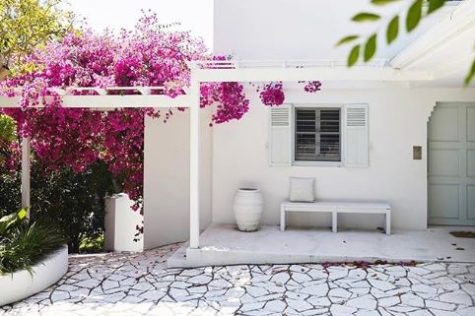Urban gardening is all about finding innovative ways to create green spaces when there’s barely room for a garden. My favourite examples of this? Green roofing and living walls.
I’ve spoken about green roofs lots of times – usually in posts where we’re looking at garden innovations, bin storage ideas or garden shed ideas. So, today, I thought I would finally get down into some detail and share my favourite green roof ideas with you.
What is a green roof?

A green roof, or living roof garden, is where the surface of a roof is covered with living vegetation (not to be confused with a rooftop garden, where there’s room to hang out). Green roof plant life is intended to be more or less self-sustaining, and to potentially provide a habitat for wildlife. Not to be confused with a rooftop garden; you won’t be able to walk on the “green” areas of your roof. Green walls are essentially the same concept, but planted on a vertical surface instead of on a roof.
What’s the point of a green roof?
I’m so glad you asked! Green roofs have several things going for them. To start with, they just look more interesting than a regular roof. I find this especially true for modern buildings, where a vibrant living roof makes an otherwise minimalist building look so much more welcoming.
Green roofing also has environmental benefits. Aside from being generally good for capturing carbon dioxide and lowering the ambient outdoor temperature, green roofs offer a habitat and food source for wildlife. A green roof can also be used to protect a building from rain damage, as the plants will absorb significantly more than a regular roof, minimising the run-off into drainage systems.
There are advantages on the inside of the building, too, as the rooftop vegetation both absorbs heat from the sun and provides insulation from cold weather. The main perk of this is that your heating and cooling costs will go down, but if you live in a high-density area, you’ll be insulated against noise, too. Green walls are also great for this.
Are there drawbacks to having a green roof?
Nothing is perfect, and there are some considerations to make before installing a green roof. For starters, there’s the up-front cost of strengthening your existing roof (to take the weight of the green layer), as well as the cost of the materials and plants to create the new roof layer. However, it should be said that the protection from a living roof can extend the lifespan of your base roof by decades. You’ll also balance the initial outlay with lower energy bills, so overall it’s still a cost-saving decision.
There will always be some level of maintenance required to make sure your green roof is thriving – even if you choose self-sufficient or drought-tolerant plants. You’ll need to keep an eye on it, and be prepared to occasionally weed, feed and water your rooftop plants (or hire a professional service to do it for you).
How do you build a green roof?
To answer that question, it’s important to first understand that there are two main types of green roof: intensive green roofs and extensive green roofs. There is also a kind of hybrid option.
Intensive green roofs
Intensive green roofs include large plants like bushes and even small trees. These are more like “roof gardens”, and are a pretty significant undertaking – which is why they’re more common on commercial properties than private homes. Intensive roof gardens need a layer of soil (or something similar), and typically have a built-in irrigation system, which add to their considerable weight.
Extensive green roofs
Extensive green roofs have a low layer of hardy plants, such as moss and sedum. These roofs are relatively lightweight, and are intended to be relatively self-sufficient in terms of watering and maintenance. Extensive green roofs can usually be built on existing surfaces, and won’t need much (if any) growing medium or soil.
Semi-extensive green roofs
The “kind of hybrid option” I mentioned is the semi-extensive green roof, which uses extensive green roof ideas, but on a layer of substrate that can support more diverse plants, like an intensive roof. Unlike an intensive green roof, a semi-extensive green roof isn’t designed to house shrubs, trees, or any other large plants.
We’ll mainly look at extensive green roof ideas in this post, as that’s almost certainly what you’ll be building at home. Also, if you’re planning to build an intensive green roof, specific, professional advice will always be leagues better than generic green roof ideas you find online.
Building a living roof garden
Even a simple living roof is made up of several layers. Closest to the roof or wall there is typically an insulation layer covered by a waterproof membrane or coating (which will need to resist the acids released from plant roots). There may also be an additional root barrier layer as extra protection for your roof. This foundation is to protect your roof from leaks or damage caused by the plants.
On top of these goes drainage, which could be clay or gravel, or a specialised perforated plastic, covered by a geotextile matting to act as a base for the soil. These layers help water filter through without damaging your plant roots, so you should either plan where the runoff should go, or look for designs that save the water for the plants to use later.
Finally, the surface of your living roof needs soil or – even better – a lightweight growing medium that can provide adequate drainage. You can usually find special blends of growing media that are designed for green roofs. Once this is laid, you can start planting! While your plants are getting established, you should cover them with an erosion control system (sometimes called “erosion blankets” or “wind blankets”), so the soil stays in place.
Green roof ideas: What to plant
There are a handful of hardy plants that are very popular in green roof and vertical garden design. When you’re choosing plants for a green roof, look for ones that are drought-tolerant and can withstand unsheltered exposure to wind, rain, snow and sunlight. Really, the best way to choose plants for a roof garden is to get some expert advice in the plants that are best suited to your local climate.
Sedum
Sedum is the most common type of plant for an extensive green roof. It’s hardy and incredibly tolerant to even the worst of British weather. Sedums are so popular (and so suited to this situation) that you can actually buy ready-grown sedum “mats” that give you instant coverage and greenery.
Lichen and moss
Moss and lichen thrive in high-moisture environments, so are fairly easy to cultivate in roof gardens in the UK. As long as you have a little bit of patience, waiting for a cover of moss and lichen is a cheap, low-effort way to get a green roof.
Grasses
Ornamental grasses are another option, and can look really stunning if you choose your variety carefully. I’ve seen green roofs covered with long blades of stipa tenuissima, which sway beautifully in the breeze. I’ve also seen gardens that have covered their shed roofs with regular turf – it looks quirky from ground level, and totally camouflages the structure from above!
Wildflowers
Planting wildflowers is a wonderful way to bring colour and vibrancy to your living roof. Plan them carefully though: mixes of annual seeds will flower immediately, but won’t return the following year. A self-seeding or perennial mix might take a year or two to get going, but will be less ongoing effort. Wildflower meadows – whether in a grass-free garden or on your roof – are excellent at attracting insects and wildlife.
Tips for healthy living plant roofs and walls
- It’s a good idea to include a waterproof layer between the garden and your home (whether that’s the roof or walls), just to reduce the risk of damp build-up.
- Out of sight should not be out of mind: even the most robust plants will need to be pruned and watered occasionally – especially in summer.
- It’s fine to start small, then increase the area of your living roof or walls once you’ve got the hang of caring for it.
- Schedule regular gutter and roofline checks – every month or so for an intensive roof, or every four months for an extensive one.
Where can you grow green roofs?
The beauty of extensive green roof systems is that they can be grown almost anywhere – perfect for urban living. If you don’t plan to put living plants on the roof of your home, you can apply green roof ideas to almost any other flat surface in your garden.
If you’re intent on a DIY project, a flat (or relatively flat) roof is going to be easiest. So, your shed, garage, bin store or rabbit hutch is probably the perfect candidate.
However, no pitch is too steep for a living roof – it just eventually becomes a vertical garden! So, if you had a cabin, greenhouse or lean-to with a pitched roof, you can still use them as a canvas for your green roof ideas. Just remember that you’ll need to compensate for the angle with ways to retain water and substrate.
You’ll also need to factor in the weight of the green roof – including when it’s covered with snow or soaked in rain.
Of course, you might be thinking about putting a green roof on your entire home – and it’s an excellent idea! Check in with your local council first though in case you need planning permission, and definitely hire a surveyor to assess how much added weight your roof can take.
No roof too small
When you want a green roof but don’t have much room (or access to an obvious roof), you’ll have to start thinking outside the box. Or, maybe that should be thinking on the box. Any box. Like a bird box. Cute, no?
Houses for the birds and the bees
Insect hotels are another wonderful way to encourage wildlife into your garden. Green roof foliage offers shelter and food for insects, so it makes perfect sense to pair the two ideas together.
Create a distraction
Choose your green roof ideas wisely and they’ll create an interesting focal point for your garden – making less thrilling features shrink into the background. For example, this gorgeous green roof in Croyden. The wheelie bins are well hidden, and according the homeowners, they often have chats with the neighbours about their gorgeous display!
Finding interesting ways to add layers and depth to your garden can be a challenge, but these green roof ideas will add texture and life in even the most unusual spaces. Don’t forget to take a look at our green wall ideas for more ways to help the environment and transform your garden!

Save this pin for later














